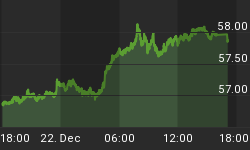Despite the sentiment picture (which is not supportive of higher prices), the price action remains sluggishly fabulous. The QQQQ (NASDAQ 100 proxy) and IWM (Russell 2000 proxy) have finally closed the week above key resistance levels; it wasn't convincing but they are above. The SPY (S&P500 proxy) and DIA (Dow Industrial proxy) have been above key levels for several weeks now but have failed to clear the next level up.
So let's look at the charts to see the areas where the major indices will succeed or fail.
Key price levels are points where buying and selling are most likely to take place. With over 40 years of back tested data, I have defined these key price levels as a pivot point low occurring at a time when investor sentiment is bearish (i.e, bull signal). These key areas are shown with the red dots in figure 1, a weekly chart of the ETF proxy for the S&P500, the S&P Deposit Receipts (symbol: SPY).
Figure 1. SPY/ weekly
Now let's stay with figure 1, and focus on the price bars with the red labeling. These are positive divergence bars between a momentum oscillator and price. Positive divergence bars tend to occur at market bottoms and are of indicative of decreasing downside price momentum. They don't always lead to trend reversals, and more likely the highs and lows of the divergence bar will define a price range. A weekly close above the highs of the positive divergence bar will lead to higher prices (and is considered a breakout) and a weekly close below the lows of the positive divergence bar will lead to lower prices (and is considered a breakdown). The highs of the current positive divergence bar are at 90.13.
My interpretation of the SPY chart is as follows: the price action has been good with three consecutive weekly closes over 86.78. Currently, prices are trading to resistance levels as defined by the highs of the positive divergence bar. A weekly close below 81.78 would be serious technical damage. A weekly close below 86.78 implies weakness and increasing caution. A weekly close over the highs of the positive divergence bar at 90.13 would be bullish. As you can see, prices have probed this area but failed on a closing basis.
Figure 2 is a weekly chart of the Dow Jones Industrial ETF proxy, the Diamond Trusts (symbol: DIA). The key levels and positive divergence bars are noted. Prices have yet to close above near term resistance at 88.36. A weekly close below 82.64 would be disastrous.
Figure 2. DIA/ weekly
Figure 3 is a weekly chart of the Power Shares QQQQ Trust (symbol: QQQQ); prices have finally cleared the upper reaches of the resistance zone as determined by the key support level at 29.72 and the highs of the positive divergence bar at 29.36. It wasn't a convincing show of strength as prices are just barely above (only 14 cents) , but it is a close above a key level nonetheless, and this should be bullish. 29.36 is now support and a weekly close below this level is a sign of weakness.
Figure 3. QQQQ/ weekly
Figure 4 is a weekly chart of the i-Shares Russell 2000 Index (symbol: IWM). Resistance levels at 48.26 have been taken out on a weekly closing basis, so this now becomes support. A weekly close below this (47.58) level is considered bearish.
Figure 4. IWM/ weekly
As we approach this holiday shortened week where light volume should be the rule, the major indices and their ETF proxies are providing a mixed picture. The QQQQ and IWM have finally closed above their most immediate overhead levels but realistically, I have to ask: where is the conviction? The SPY and DIA appear to be further along in the bottoming process but have failed at the next resistance levels. As discussed previously, sentiment is mixed. As always, we give the market the benefit of the doubt, yet of course, we should be on the alert for failures at our key price levels.















